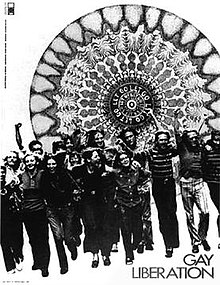Gay Liberation Front
Police raids of the Stonewall, and other lesbian and gay bars, were a routine practice at the time, with regular payoffs to dirty cops and organized crime figures an expected part of staying in business.
The lesbian and gay crowd also freed staff members who had been put into police vans, and the outnumbered officers retreated inside the bar.
Soon, the Tactical Patrol Force (TPF), originally trained to deal with war protests, were called in to control the mob, which was now using a parking meter as a battering ram.
As the patrol force advanced, the crowd did not disperse, but instead doubled back and re-formed behind the riot police, throwing rocks, shouting "Gay Power!
The meeting was attended by over 40 people including Martha Shelley, Marty Robinson, Bill Katzenberg, Lois Hart, Suzanne BeVier, Ron Ballard, Bob Kohler, Marty Stefan, Mark Giles, Charles Pitts, Pete Wilson, Michael Brown, John O’Brien, Earl Galvin, Dan Smith, Jim Fouratt, Billy Weaver, Jerry Hoose, Leo Martello and others.
“Front” denoted an umbrella coalition uniting a diverse group of lesbian and gay people despite their differences in class, age, gender, race and ethnicity.
The meeting then authorized Lois Hart, Michael Brown and Ron Ballard to compose a statement of purpose that appeared in the next issue of “Rat,” a prominent New York radical movement newspaper at that time.
[10][9] One of GLF's early acts included organizing a march protesting coverage of gay people by The Village Voice, which took place on September 12, 1969.
[11][9] Long before the word "intersectionality" came into use, the GLF had a broad political platform, denouncing racism and declaring support for various Third World struggles and the Black Panther Party.
[14] In 1970, several GLF women, such as Martha Shelley, Lois Hart, Karla Jay,[15] and Michela Griffo went on to form the Radicalesbians, a lesbian activist organization.
[18][6][19] In 1970, several Black and Latinx members of the GLF, including graphic artist Juan Carlos Vidal and poet Néstor Latrónico, formed Third World Gay Revolution (T.W.G.R.
[36] The protesters "used the ink to scrawl slogans on the building walls" and slap purple hand prints "throughout downtown [San Francisco]" resulting in "one of the most visible demonstrations of gay power" according to the Bay Area Reporter.
[29][31][34] According to Larry LittleJohn, then president of Society for Individual Rights, "At that point, the tactical squad arrived – not to get the employees who dumped the ink, but to arrest the demonstrators.
[45] The GLF Manifesto was published, and a series of high-profile direct actions, were carried out, such as the disruption of the launch of the Church-based morality campaign, Festival of Light.
Amongst GLF members taking part in this protest were the "Radical Feminists", a group of gender non-conforming males in drag, who invaded and spontaneously kissed each other;[47] others released mice, sounded horns, and unveiled banners, and a contingent dressed as workmen obtained access to the basement and shut off the lights.
The Leicester Gay Liberation Front founded by Jeff Martin was noted for its involvement in the setting up of the local "Gayline", which is still active today and has received funding from the National Lottery.
The Front de Libération Homosexuel (FLH) was formed in November 1970, in response to a call for organised activist groups in the city by the publication Mainmise.
[55] Another factor in the group's formation was the response from police against gay establishments in the city after the suspension of civil liberties by Prime Minister Pierre Trudeau in the fall of 1970.
BBF's activities included going to schools to educate about how it was like being gay, and civil disobedience against the law that prohibited men from publicly dancing together, which was eventually repealed in 1973.
In the following months Gay Liberation Fronts established in Wellington, Christchurch and Hamilton, with further groups founded in Rotorua, Nelson, Taranaki, and other places between 1973 and 1977.
[59] Supporting the wellbeing of gays and helping them to come out was an early concern of the movement, leading to the formation of counselling services such as Gay-Aid in Wellington and Gays-An in Christchurch.




